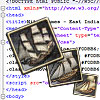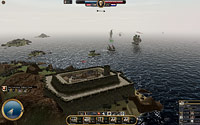- Overviews
- East India Company
- Pirate Bay
- Privateer
- Designer's Cut
- Battle of Trafalgar
- Collection
- Ship Introductions
- Designer's Blog
- Developer's Video Diary
- Modding Instructions-series
 9th October 2009:
9th October 2009:Modding part 6.
This time we learn how to translate the East India Company to your own language.
Read more » 15th July 2009:
15th July 2009:Naval warfare, part II.
Lead designer Kim Soares takes the helm of a frigate and shouts: "Port side, FIRE!"
Read more »
 Keep yourself posted on the latest news about East India Company.
Keep yourself posted on the latest news about East India Company.
Email-address:
 Sign up for the Paradox newsletter, and get all the news directly from Paradox Interactive.
Sign up for the Paradox newsletter, and get all the news directly from Paradox Interactive.
Email-address:


Designer's Blog: Challenge result in satisfaction
Game should be challenging but not overly difficult
East India Company is very close to being completed. Design and testing have been very busy with nailing down the right difficulty level for the game.

I don't know if you have noticed it or share the opinion, but too many games tend to be walk in the park no-brainers. I don't know where it is coming from, but somebody somewhere obviously thinks that gamers are not having good time if they have to make an effort.
During Christmas holidays, I rediscovered SSI's Panzer General. It is perhaps the game I personally have spent most hours on. It is "just" turn-based strategy game with hex-grid, but if you do not know what you are doing, you're going to lose. Plain and simple. And even when you know perfectly well what you are doing, the game can still kick your ass. I wrote strategy guide for Panzer General to a games magazine once and still 12 years later I'm getting bloody nose trying to invade England.
In Panzer General you can always load a saved game, if everything seems to go to hell in a handbasket. Being a great fan of Warhammer 40,000, another game I want to mention here is Chaos Gate, also from SSI.
Chaos Gate is turn-based tactical game, where you lead a group of space marines. Your marines, you have about 40 of them, gain experience and you want to keep them alive. If they die you get no replacements. The real nasty part was that when you played with hard difficulty, you had only one save slot in use. And whenever one of your marines bit the dust the game immediately auto-saved.
Hard? Yes, but it was also very satisfactory to get all your men back from the field alive after
successful mission.

Use your head
In East India Company there are many aspects to tune in regards of difficulty. One is the plain and simple economy. How large profits should we allow player to get? EIC has dynamic economy, meaning that importing stuff to your Home Port will gradually decrease its price. It also works the other way around too: If you have not brought some particular item to your Home Port for few years, its price will shoot up.
I personally enjoy hoarding money in games, but making it too easy would water down the fun. The game should not play itself for the player, but instead the player should make an effort himself. In this example, to pay attention to price development. Things are not as straightforward as just calculating profits though. Prices for ships, building upgrades, diplomatic actions and many other things all play their part.
Of course, gameplay that requires using your head differs from gameplay based on fast reaction and accurate mouse hand. Naval combat in East India Company actually require both. As developers we're in that happy position that our combat AI works well.
Difficulty here is related to things like how much damage different cannons inflict and how easy it is for the player to handle multiple ships and give them commands in quickly changing situations. As we know, AI has no difficulty in being aware of all the things at once. Combat AI in East India Company does not cheat and neither does it need any help like damage bonuses to be able to put up a fight.
Difficulty is difficult thing. If game is too hard, it can turn away some players. If it is too easy, it will do the same. In my opinion too hard is better than too easy. You can always get better yourself, be able to beat a hard game and then get the feeling of satisfaction from your accomplishment. But if game is too easy, it is impossible to inject challenge into it.
And let's face it, it is all about challenge. If there is no challenge, succeeding is worthless.
I hope you will find East India Company challenging and fun.
Kim Soares







